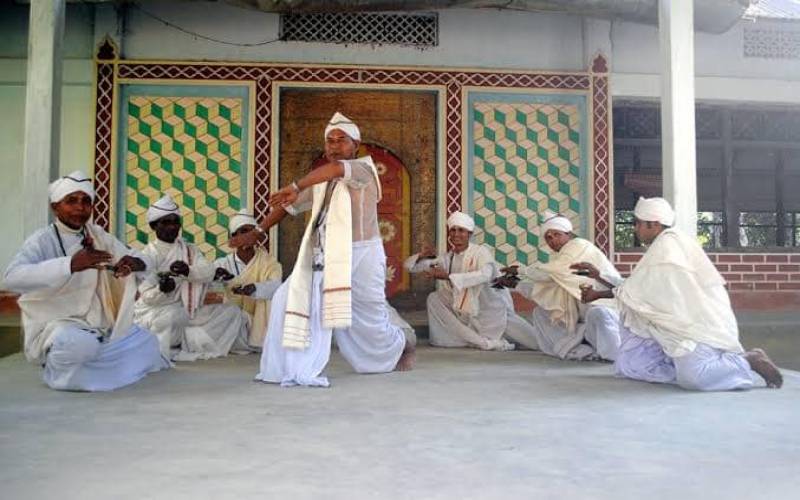Author: Nagaranjitha S, Varanasi (Banaras University)
Published as a part of Śāstra Raṅga-2023 Internship ; offered by NoopuraBhramari- IKS Centre. Article series No – 16
The satras[1] of Assam is where Śrīmanta Śankaradeva[2] spread vaiśnavism through his dramas, poems, dance, and music. The traditional theatre performed in these satras are called as Aṅkiya Bhaona. These plays which were embedded with music, and dance written by Śankaradeva and his disciples like Mādhavadeva are called Aṅkīya Nāṭ[3]. These theatricals were meant for the satras where only the men performed. Satriya was the nṛtya aspect within the nāṭya that was performed, that later got incorporated into a proscenium stage as an individual entity. These art forms originate from satras and hence the name Satriya. It involves many varieties. One such is an Ojāpālī satriya that is found in the kamalābārī satras, also known as biyāhiya ojā pālī or biyāhar ojā pālī. Because of its origin it includes the grammar of dance dramas. Interestingly in Ojāpālī we can observe some Nāṭyaśāstra aspects as well as deviations from it.
An Ojāpālī is a group performance involving five to six men called the pālī and an Ojā, who are the actors, singers, as well as dancers (Durgavar, 2016). An Ojā is the person who leads the troupe. He conveys the meaning and objective of the recitation, like a sutradhāra in the pūrvaraṅgavidhi described by Bharata, through his nṛtya. He has specific hand gestures and fee movements and brow movements that are all derived based on the āṅgika grammar of satriya[4] (Venkaṭaraman, 2019).

Picture showing an Ojā performing along with the other pālīs. Photo from www.gosahin.com (Ojapali Traditional Folk Dance, Information, Origin, Style, n.d.)
Both vaiśnava and śākta cult-based narrations are observed in Ojāpālī. The śākta form of Ojapāli starts with the recitation of songs on nāga devī manasā, the guardian deity of eastern India along with śiva, durga, and śītala. So, there are two things to be observed here. One is that the compositions on Rāmāyaṇa, Mahābhārata are sang by the troupes. The kālīya daman, Rukmini karaṇam, are some of the nāṭakas composed by Śaṅkaradeva himself and the Ojā bān prastuti in Ojāpālī are the songs of these nāṭakas to which the Ojā dances along. Clearly, we can see that it is an uparūpaka tradition that has evolved out of the rūpaka tradition. The second observation is that an Ojā’s conduct here is much like in the parivartana of pūrvaraṅgavidhi where sūtradhāra enters and invokes the guardian deities. Here Ojā usually does the Vandanā of different deties like gaṇeśa viṣṇu kṛśṇa pārvatī and sūrya. Daināpālī[5] accompanies him in doing specific dance movements and gestures. While Ojā coneys the stories and Dainapālī assists him, takes discussions on the themes[6] and adds comical elements in their conversation. The trigata in pūrvaraṅgavidhi described by Bharata consists of the three men involve in conversation – sūtradhāra, vidūṣaka and paripārśvaka. However, here we see that the Dainapāli does both the jobs of vidūṣaka and paripārśvaka in Satriya Ojāpālī.
Further, Ojāpālī brings in that āṅgika prayoga along with vācikābhinaya that alludes to the citra pūrvaraṅga adaptation by the form. Under Prārocana of pūrvaraṅgavidhi Bharata says “punaḥ kārhaḥ kāvyavastunirūpaṇam (Unni, 2014). Likewise, the Ojā in Ojāpālī describes the subject of the performance which suits its format to a citra pūrvaraṅga[7] type.
However, it is very interesting to see that, what could have been a preliminary ritual or a pūrvaraṅgavidhi for the plays composed by Śaṅkaradeva, over a period must have got evolved as a separate entity where the director the play himself became a central point of the performances, and he dances out for the songs that narrate various episodes along with his accompaniments.
The ekāhārya format that Ojāpālī has adapted to portray the various characters through nṛtya also suggests the same. Whether due to rūpakas going out of vogue or the impact of bhakti movement, whatever be the reason for the change, Ojāpālī has come a long way in this path of evolution and calling it as a mere “folk dance” just limits the vastness and depth of the form. It is a beautiful piece of heritage which is a proof that nāṭyaśāstra concepts have spread across the length and breadth of our nation, have been carried forward in time, have gone through evolution showing so many regional variations based on geographical location.
———–
[1] Can be understood as maṭhas or the vaiśnaiva monasteries.
[2] Saint who lived between 1449 and 1568 in Assam who was also an artist, composer, and musician.
[3] Satriya classical dance of Assam is one such that has been derived from the aṅkiya nāṭ traditional theatre tradition.
[4] Āṅgika Both Nāṭyaśāstra as well as Śrīhastamuktāvaḻī is observed in the form.
[5] Dainapāli is synonymous to Dakṣiṇapāli as they stand to the right of an Ojā.
[6] Usually themes are like rukmiṇī haraṇ, kāliyā daman, prahlād caritam and so on.
[7] Abhinavagupta mentions the four types of pūrvaraṅga among which the one that involves nṛtta as citra pūrvaraṅga.
References